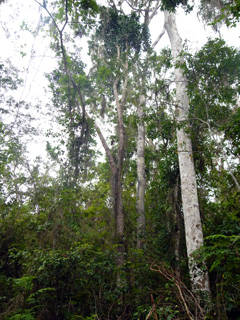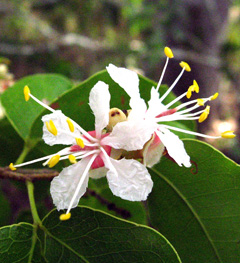 |
|
Matt Lavin |
 |
| Domingos Cardoso - Flickr |
Translate this page:
Summary
Goniorrhachis marginata is an evergreen tree with a globose canopy and straight, cylindrical bole that can be 70-90 cm in diameter. It usually grows up to 30 m tall. It is commonly found in South America. Fully established plants are tolerant to drought. The wood is of high quality and ideal for construction especially in exposed situations. It is very heavy, very hard, and highly durable.
Physical Characteristics

 Goniorrhachis marginata is an evergreen Tree growing to 25 m (82ft) by 20 m (65ft) at a medium rate.
Goniorrhachis marginata is an evergreen Tree growing to 25 m (82ft) by 20 m (65ft) at a medium rate.
See above for USDA hardiness. It is hardy to UK zone 10.
Suitable for: light (sandy), medium (loamy) and heavy (clay) soils and prefers well-drained soil. Suitable pH: mildly acid, neutral and basic (mildly alkaline) soils. It cannot grow in the shade. It prefers moist soil and can tolerate drought.
UK Hardiness Map
US Hardiness Map
Synonyms
Goniorrhachis marginata var. marginata
Plant Habitats
Edible Uses
References More on Edible Uses
Medicinal Uses
Plants For A Future can not take any responsibility for any adverse effects from the use of plants. Always seek advice from a professional before using a plant medicinally.
None known
References More on Medicinal Uses
The Bookshop: Edible Plant Books
Our Latest books on Perennial Plants For Food Forests and Permaculture Gardens in paperback or digital formats.

Edible Tropical Plants
Food Forest Plants for Hotter Conditions: 250+ Plants For Tropical Food Forests & Permaculture Gardens.
More

Edible Temperate Plants
Plants for Your Food Forest: 500 Plants for Temperate Food Forests & Permaculture Gardens.
More

More Books
PFAF have eight books available in paperback and digital formats. Browse the shop for more information.
Shop Now
Other Uses
Wood
Other Uses: The wood is medium-textured, straight to slightly cross-grained, very heavy, very hard, and of great durability even when exposed to the elements. It can be used for all types of construction, especially in exposed situations, flooring blocks and is considered to be one of the best woods for railway sleepers[420 ].
Special Uses
References More on Other Uses
Cultivation details
Grows best in a sunny position[420 ]. Established plants are drought tolerant[420 ]. Young plants have a moderate rate of growth[420 ]. Although many species within the family Fabaceae have a symbiotic relationship with soil bacteria, this species is said to be devoid of such a relationship and therefore does not fix atmospheric nitrogen.
References Carbon Farming Information and Carbon Sequestration Information
Temperature Converter
Type a value in the Celsius field to convert the value to Fahrenheit:
Fahrenheit:
The PFAF Bookshop
Plants For A Future have a number of books available in paperback and digital form. Book titles include Edible Plants, Edible Perennials, Edible Trees,Edible Shrubs, Woodland Gardening, and Temperate Food Forest Plants. Our new book is Food Forest Plants For Hotter Conditions (Tropical and Sub-Tropical).
Shop Now
Plant Propagation
Seed - best sown as soon as it is ripe in a partially shaded position in a nursery seedbed. A high germination rate can usually be expected from fresh seed, with the seed sprouting within 8 - 15 days[420 ]. When the seedlings are 4 - 5cm tall, pot them up into individual containers and they should be ready to plant out 4 - 5 months later[420 ]. The seed has a limited viability of less than 60 days in storage[420 ].
Other Names
If available other names are mentioned here
Goniorrhachis
Native Range
SOUTHERN AMERICA: Brazil (Bahia)
Weed Potential
Right plant wrong place. We are currently updating this section.
Please note that a plant may be invasive in one area but may not in your area so it's worth checking.
Conservation Status
IUCN Red List of Threatened Plants Status : This taxon has not yet been assessed

Growth: S = slow M = medium F = fast. Soil: L = light (sandy) M = medium H = heavy (clay). pH: A = acid N = neutral B = basic (alkaline). Shade: F = full shade S = semi-shade N = no shade. Moisture: D = dry M = Moist We = wet Wa = water.
Now available:
Food Forest Plants for Mediterranean Conditions
350+ Perennial Plants For Mediterranean and Drier Food Forests and Permaculture Gardens.
[Paperback and eBook]
This is the third in Plants For A Future's series of plant guides for food forests tailored to
specific climate zones. Following volumes on temperate and tropical ecosystems, this book focuses
on species suited to Mediterranean conditions—regions with hot, dry summers and cool, wet winters,
often facing the added challenge of climate change.
Read More
Expert comment
Author
Taub.
Botanical References
1
Links / References
For a list of references used on this page please go here
A special thanks to Ken Fern for some of the information used on this page.
Readers comment
| Add a comment |
|
If you have important information about this plant that may help other users please add a comment or link below. Only comments or links that are felt to be directly relevant to a plant will be included. If you think a comment/link or information contained on this page is inaccurate or misleading we would welcome your feedback at [email protected]. If you have questions about a plant please use the Forum on this website as we do not have the resources to answer questions ourselves.
* Please note: the comments by website users are not necessarily those held by PFAF and may give misleading or inaccurate information.
To leave a comment please Register or login here All comments need to be approved so will not appear immediately.
|
Subject : Goniorrhachis marginata
|
|
|
|